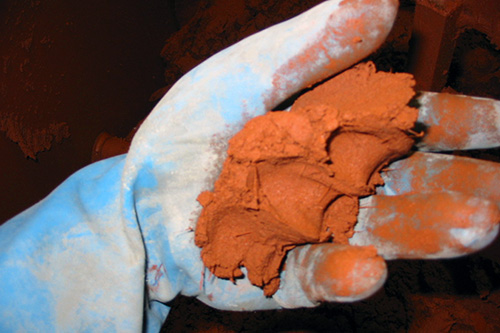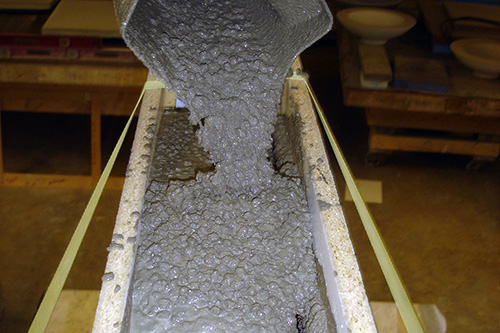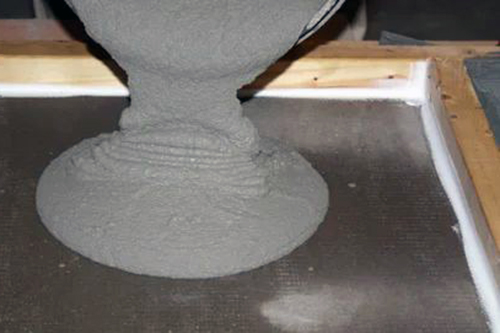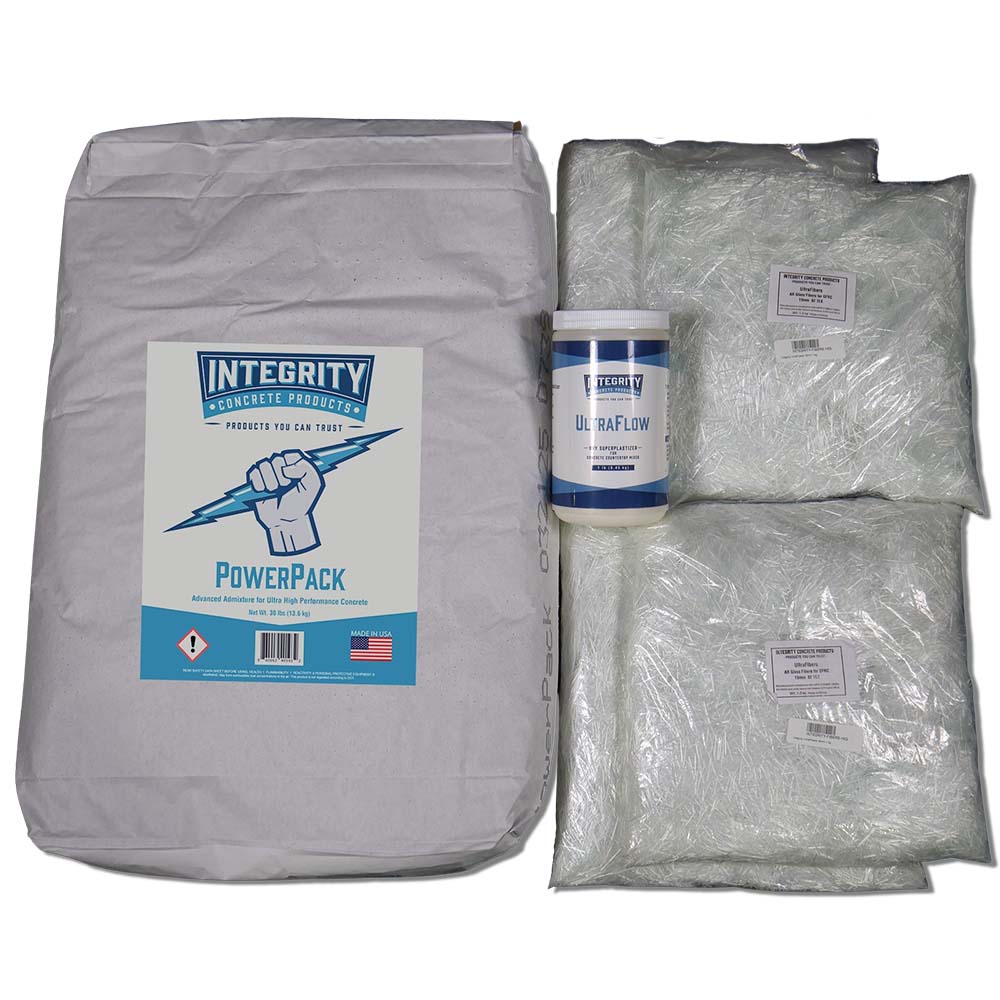The best concrete countertop mix recipes balance strength, workability, and surface finish. There are two paths to take:
- make your own concrete countertop mix, or
- buy a bagged mix specifically designed for concrete countertops
There are pros and cons to both approaches. (More on that in this article.) At The Concrete Countertop Institute, we empower you to choose either, confidently, by helping you fully understand how concrete really works. Regardless of which path you choose, you will be better able to troubleshoot or adjust for your climate and working conditions.
Note also that even if you use the best mix in the world, if you use bad concreting practices such as adding too much water, not reinforcing properly or not curing properly, then your mix won’t matter. Or if you don’t know how to manipulate the mix to get the look you want, that best mix won’t help you produce beautiful concrete. (More on that in this article.)
This article will give you a comprehensive understanding of what to look for in concrete countertop mixes, covering:
Types of Concrete Countertop Mixes
Before we talk about what is the best concrete countertop mix, you need to understand that there are many different styles of concrete countertop mixes:
- all-sand mixes designed to be stiff and hand packed
- aggregate-based mixes designed for vibration or cast in place
- polymer-based mixes that flow like pancake batter
- GFRC mixes
- Stiff mix, all sand
- Aggregate based mix
- Flowable mix
- GFRC mix
None of these styles are necessarily better or worse, because different applications call for different mix and casting styles. However, the mix style and technique most commonly used by creative concrete professionals is GFRC.
Requirements of Good Concrete Countertop Mixes
Unlike sidewalks or foundations which are slabs on grade, concrete countertops are generally long, slender, thin beams. They not only behave very differently structurally from slabs on grade, but also have very different aesthetic requirements. For example, color is not an important consideration in structural concrete mix design, but it is in concrete countertop mix design.
Regardless of the style of mix, the following basic principles apply.
- High early strength so you can process and finish faster
- High flexural strength for greater crack resistance
- Low shrinkage potential which minimizes curling
- Suitability to the project needs
1. High Early (Compressive) Strength
Compressive strength is not an indicator of a high quality concrete countertop mix. However, high early (compressive) strength is important early on. This is when you need to get the concrete out of the forms, flip it over and start processing it as soon as possible to get it into your client’s home. Concrete that develops high compressive strength quickly is going to be harder than concrete that develops strength more slowly. This means that the cement paste between the hard sand grains and aggregate will be harder, and the concrete can be ground and polished sooner.
High early strength is accomplished by using a low water to cement ratio, proper pozzolan loading, and cement contents higher than construction grade concrete.
2. High Flexural Strength
For traditional precast concrete, steel reinforcing is still essential, since the flexural strength of concrete is always much, much lower than the compressive strength. For example, the predicted value of flexural strength for ordinary construction concrete that has a very high compressive strength of 12,000 psi is only about 900 psi! But, if the flexural strength of your concrete is as high as possible, it is going to better withstand bending (flexural) forces along with the steel reinforcement, and show less cracking.
High flexural strength is achieved through both mix design and proper reinforcement. Steel reinforcing in precast concrete countertops effectively boosts flexural strength values many times that of unreinforced concrete. GFRC concrete countertops use a special mix design and high glass fiber loads that create high flexural strength.
3. Low Shrinkage Potential
Shrinkage can cause either cracking for restrained slabs or curling for unrestrained slabs. Shrinkage occurs when the cement paste dries out. Moisture evaporating from inside the concrete causes strong capillary suction forces in the cement paste that cause it to shrink. If the shrinkage forces are high enough, the concrete cracks.
The underlying causes of this can be poor curing practices (allowing the concrete to dry out too soon before it’s strong enough to resist the suction forces), too much mix water, too much cement in the mix, or poor aggregate gradation that requires too much cement paste to achieve good workability.
Shrinkage reducing admixtures (SRA’s) are chemicals that reduce the suction forces generated during evaporation. This helps reduce the root cause of cracking and curling: the suction forces in the cement paste.
Proper curing also combats shrinkage. For example, curling occurs when one face of a countertop shrinks more than the other side, and the result is that the countertop curls towards the side that shrank more. It can occur if one side of the slab remains wet and the other side is dry. Curling is a symptom of shrinkage. Concrete mixes that don’t exhibit significant amounts of shrinkage don’t curl much or at all.
4. Suitability to the Project Needs
Every project has aesthetic, economic, structural and other practical needs. The choice of a particular concrete mix must take all of those into account.
For example, I could never, ever make anything as thin and strong (like a lounge chair) from a generic bag of Quikrete concrete mix from home depot without radically changing the thickness of the piece, how it’s cast, or most importantly how it’s reinforced.
The mix you choose has inherent capabilities and limitations: cost, availability, aesthetics, versatility, compressive and flexural strength, shrinkage, etc. Choosing one mix vs another involves far more than simply knowing the ingredients in the mix, or finding reassurance from an online testimonial that “it’s the best!”.
Knowing what that mix can do, how it can be manipulated, what its limitations and drawbacks are, and the overall suitability to a specific application are the principle keys to knowing how to choose the right mix and how to be successful with it.
Where to Buy Concrete Countertop Mix
From Scratch
If you want to go the from-scratch route, you can purchase individual ingredients. You just need a good mix formula. See “Concrete Countertop Mix Recipes” below.
It also helps to have a mix calculator that can eliminate the mathematics required, especially for GFRC mixes. If you want to know exactly what the math is, see this article. If you just want to use a calculator, click here.
Having a good scale is also extremely important. Click here for a detailed article about scales.
Bagged Mix
If you want to go the bagged mix route, there are many concrete countertop mixes on the market. Some are by large corporations that focus on commercial concrete, and they are available in “big box” home centers. These are not the type of mixes that creative concrete professionals use.
Several companies, who have expertise in concrete countertops, have developed mixes specifically formulated for concrete countertops. Typically these focus on GFRC, although other styles are also available.
The Concrete Countertop Institute has developed the Integrity Concrete Products line of mixes and ingredients, based on years of testing and sound engineering. Click here for the Integrity Concrete Products line.
Concrete Countertop Mix Recipes
Regardless of which mix you choose, it is important to follow the manufacturer’s recommended mix recipe and mixing instructions.
It is especially important to know exactly how much cement is in the mix, because the most important ingredient in concrete is dosed based on this: Water. Water/cement ratio is the biggest determinant of the quality of the concrete. Any high quality concrete countertop mix should recommend no more than a 0.35% w/c ratio. Click here to learn more about the importance of water in concrete.
Below is a white concrete countertop mix recipe for GFRC using 1 bag of Integrity PowerPack.
| English: | Metric: |
| Sand – 122.95 lb | Sand – 55.770 kg |
| Portland cement – 97.25 lb | Portland cement – 44.114 kg |
| Integrity PowerPack– 30.00 lb | Integrity PowerPack– 13.608 kg |
| Water (w/c = 0.30) – 36.88 lb | Water (w/c = 0.30) – 16.729 kg |
| AR Glass Fibers 19mm (2.5%) – 7.36 lb | AR Glass Fibers 19mm (2.5%) – 3.339 kg |
| Total Cementitious Material: 122.95 lb | Total Cementitious Material: 55.770 kg |
| Total Concrete Weight: 294.45 lb | Total Concrete Weight: 133.771 kg |
| Makes 34.14 sq ft @ 3/4″ thick, 25.60 sq ft @ 1″ thick, 2.134 cubic ft | Makes 3.172 sq m @ 20 mm thick, 2.379 sq m @ 25 mm thick, 0.0604 cubic meters |
For an even simpler concrete countertop mix, use Integrity PowerBlend and just add water.
More Information
For free training on exactly how all of the ingredients of concrete work (sand, cement, water, admixtures), click here.
For more information about concrete countertop mix designs, click here.
To learn about GFRC, click here.





